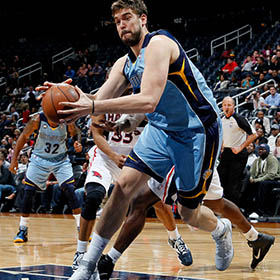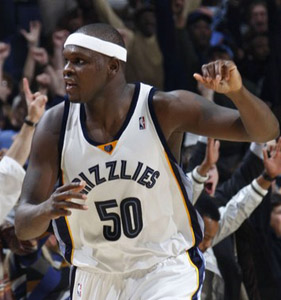Now? Popovich and his San Antonio Spurs may soon be seeing more of Marc Gasol. That overweight high schooler who liked shooting threes and, in the eyes of many locals, wasn’t good enough to play for White Christian High School, has blossomed into the NBA’s best all- around center on a team that dropped Sunday’s opener of the Western Conference finals to the San Antonio Spurs.
around center on a team that dropped Sunday’s opener of the Western Conference finals to the San Antonio Spurs.
“Did I have any idea this would happen? That he would become the NBA Defensive Player of the Year and a certain All-Pro? No, I didn’t,” Wallace said. “We thought when we made the deal that he could become a top-10 center in the league at some point.”
The deal that appeared so one-sided back then is now looking a lot better for Memphis. The original trade had Pau Gasol and a second-round pick going to the Lakers for Kwame Brown, Javaris Crittenton, Aaron McKie and two first-round picks.
Crittenton was sent to Washington for a first-round pick. Brown left as a free agent. McKie was used to make the cap numbers work, never playing a game for the Grizzlies. The two first-round picks turned out to be Darrell Arthur, now the team’s first big man off the bench, and Greivis Vasquez, who was traded to New Orleans for Quincy Pondexter, another key sub for this year’s Grizzlies.
But the trade also created a ton of cap room for Memphis – Wallace estimated as much as $20 million – and the Grizzlies used the bulk of it to sign Zach Randolph, who they acquired from the Clippers for Quentin Richardson in 2009. That deal would not have been possible had not the Clippers won the 2009 lottery and thus been able to select Blake Griffin.
At one point not too long ago, Wallace said, he could look at the Grizzlies roster and see seven or eight players who were byproducts of the Gasol-Gasol deal. Now there are four: Marc,  Randolph, Arthur and Pondexter. There’s also a second round pick from Toronto coming in a few years that can be traced to the trade.
Randolph, Arthur and Pondexter. There’s also a second round pick from Toronto coming in a few years that can be traced to the trade.
“We like to think that Pau is the NBA version of an organ donor,” Wallace said. “We’re still living on what we harvested from him.”
And living large indeed. Marc Gasol should make First Team All-NBA, something his more celebrated and more decorated brother has never done. Randolph has become an All-Star and an absolute beast in the post. Arthur and Pondexter are regulars off a deep Memphis bench.
The fans that had deserted the team in droves (the Grizzlies were second class to Memphis University at that point) are now back – loud, boisterous and committed.
“This is the best basketball city in the south,” Wallace said. “We knew if we could get a good team, they’d come back. There’s great tradition here, from the Memphis State teams that went to the Final Four to the great coaches like Gene Bartow to the players like Penny Hardaway. We just had to give them a reason to come.”
At the time the deal was made, Pau had never won a playoff series, let alone a championship, and Marc had never played in an NBA game. In the truest sense of the cliché, this was a deal that benefited both teams. For the Lakers, the impact was immediate. For the Grizzlies, it took a lot longer.
But boy, is it paying off right before our very eyes. There is, most definitely, a reason to come.
Peter May is the only writer who covered the final NBA games played by Larry Bird, Magic Johnson and Michael Jordan. He has covered the league for three decades for The Hartford Courant and The Boston Globe and has written three books on the Boston Celtics. His work also appears in The New York Times. You can follow him on Twitter.
Those of us who had seen Spain play on the world stage knew Marc Gasol was a valuable piece when the Lakers gave him up, and the trade not “lopsided” at all. Everyone else (including the media) thought (and still think today) the Grizzlies got played. Marc and Pau are both great ballers but both need to be in the right system to take advantage of their strengths.